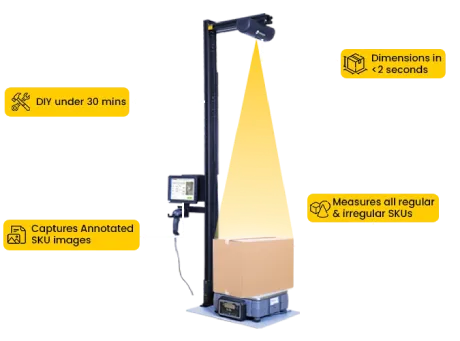Dimensional Measuring Systems
What are dimensional measuring systems and why do they matter for shippers?

How can one wrong inch raise your shipping costs?
Example
- Recorded: 18 × 18 × 18 inVolume: 5,832 in³. With a DIM divisor of 139, the DIM weight is 41.96 lb. Most carriers round up, so you pay for 42 lb.
- Actual: 19 × 18 × 18 inVolume: 6,156 in³. DIM weight is 44.30 lb. Rounded, you pay for 45 lb.
The hidden costs you feel later
- Lower trailer utilization, which means paying for more trucks than you need
- Slower claim resolution when your records do not match the carrier’s
- Extra labor spent on re-measuring, repacking, and explaining disputes
Why can’t manual dimensional measurement tools keep up with parcel shipping needs?
Measurement errors: A tape pulled at the wrong angle adds half an inch. A worker rounding down saves time but creates false data. Even a simple mistake like swapping length and width can trigger higher shipping charges. Carriers always measure again on their own equipment, and when numbers do not match, a surcharge arrives.
Time-Consuming process: Measuring one box by hand takes 15 to 20 seconds if done carefully. Writing or typing the dimensions into a system adds another 10 seconds. That is half a minute for one parcel. At 500 parcels a day, more than four hours vanish on just measuring. Multiply by a week or a month and the wasted labor is clear.
Inconsistent results: Ten workers can measure the same carton and come back with ten slightly different results. One rounds up, other rounds down, another measures with the tape pressed too tightly. The carrier’s scan is the only version that matters, which means internal records often carry no weight in a dispute.
Hidden costs: Manual tools look cheap at purchase but expensive in use. Lost labor hours, rework, and repeated disputes all eat into margins. A simple mismeasurement can make a low-margin parcel unprofitable after one surcharge.
What are dimensional measuring systems?
A dimensional measuring system is an automated device or equipment that captures the length, width, and height of parcels, polybags, cubes, cuboids and irregulars in less than a second. Most systems like vMeasure also record weight and images in the same process. Instead of relying on a person with a tape measure, the system scans the parcel in seconds and pushes the data directly into the warehouse or shipping software.
How do dimensional measuring systems work?
A warehouse employee places the parcel on the automated dimensional measuring systems’ platform or on the conveyor.
Many systems have an integrated weight scale. As the box is measured, weight is recorded at the same time. This eliminates the need for a second step on a separate weighing station.
What types of dimensional measuring systems are available in the market?
1. Static Parcel Dimensioning Systems
2. Pallet Dimensioning Systems
Pallet systems measure freight and overhangs. Instead of scanning individual parcels, they capture the dimensions of a fully palletized shipment. These systems are common in LTL shipping, distribution centers, and cross-dock facilities where pallets move directly onto trailers
3. Conveyor-Based Parcel Dimensioning Systems
Conveyor systems are built for speed. Parcels move down a conveyor belt, and the system measures them automatically as they pass. Dimensions, weight, barcodes and even images are captured in motion.
4. Mobile or Handheld Dimensioning Tools
Mobile systems, such as iOS applications, turn an iPhone into a handheld scanner. Carriers and couriers often use them in field operations like pickup and delivery, and warehouses use them to ensure instant parcel verification.
What are the benefits of using dimensional measurement systems?
Accurate billing: Carriers charge by dimensional weight, not just actual weight. These systems ensure your records match theirs. That means fewer chargebacks, fewer disputes, and cleaner invoices.
Faster processing: Manual measuring takes half a minute per parcel. This system does it in seconds. In high-volume shipping, the time saved per box adds up to hours saved each day.
Consistent results: Measurements are the same regardless of who is working at the station. This builds carriers trust and gives teams reliable data to work with.
Lower labor costs: Automated dimension capture reduces the need for workers to spend time measuring, rechecking, and typing numbers into a system. Staff can focus on packing, loading, and other tasks that move shipments forward.
Software integration: Measurements flow directly into your existing WMS, TMS, or carrier software. That removes manual entry errors and creates a real-time view of shipping costs and trends.
Customer confidence: Images and accurate dimensions give a record that can be shared if a customer disputes a shipment. Having proof on file reduces back-and-forth and shows professionalism.
How to choose the right dimensional measuring system?
Parcel volume:
- Low to medium: A static station can handle hundreds of parcels a day at the packing bench.
- High volume: Conveyor-based systems process thousands of parcels per hour with little human input.
Parcel type:
- Consider the mix of parcels you handle. Regular cartons, polybags, and even odd-shaped irregulars or bulky items can all be measured with a single dimensional measuring system, such as vMeasure, which offers adjustable mount heights.
Warehouse space:
- Limited space: Compact static stations or mobile devices are the practical choice.
- Larger facilities: Conveyor systems make sense if you have the floor space to dedicate to automation.
- Check if the system connects to your WMS, TMS, or shipping software. Without integration, you risk replacing manual measuring with manual data entry, which defeats the purpose.
- Most parcel systems measure within ±0.2 inches. For high-value shipments or strict carrier contracts, that level of precision makes a difference.
- Entry-level static systems are affordable and pay back quickly for small shippers.
- Conveyor systems cost more up front but save far more in labor and correction fees once volume is high.